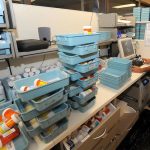What is a pilonidal sinus?
A pilonidal sinus is a problem in your natal cleft (the area between your buttocks) that can cause infection.
Hairs can grow in your natal cleft, or loose hairs can fall and collect in your natal cleft.
Hairs carry bacteria, which can cause inflammation and infection.
An abscess (a collection of pus) can form or the pus can drain through a tunnel (sinus) out to your skin.

What are the benefits of surgery?
Surgery is the most dependable way to remove the pilonidal sinus and pockets of infection.
Are there any alternatives to surgery?
Washing your natal cleft every day to prevent hairs building up and removing hair from the area by waxing or using a hair removal cream may help to prevent an infection.
An occasional discharge can be treated with antibiotics.
It is sometimes possible to have a procedure under a local anaesthetic to drain an abscess, or to brush the sinuses and fill them with glue or phenol, and also to remove the pits.
What does the operation involve?
The operation is performed under a general anaesthetic and usually takes about 30 minutes.
Your surgeon will remove the sinus and infected tissue, sometimes over a large area.
How can I prepare myself for the operation?
If you smoke, stopping smoking now may reduce your risk of developing complications and will improve your long-term health.
Try to maintain a healthy weight. You have a higher risk of developing complications if you are overweight.
Regular exercise should help to prepare you for the operation, help you to recover and improve your long-term health. Before you start exercising, ask the healthcare team or your GP for advice.
Speak to the healthcare team about any vaccinations you might need to reduce your risk of serious illness while you recover. When you come into hospital, practise hand washing and wear a face covering when asked.
What complications can happen?
Some complications can be serious and can even cause death.
General complications of any operation
- bleeding
- allergic reaction to the equipment, materials or medication
- blood clot in your leg
- blood clot in your lung
- chest infection
Specific complications of this operation
- partial breakdown of your wound
- slow healing
- numbness around your wound
- the problem coming back
Consequences of this procedure
- pain
- unsightly scarring of your skin
How soon will I recover?
You should be able to go home the same day.
You should be able to return to work after 2 to 3 weeks.
Regular exercise should help you to return to normal activities as soon as possible. Before you start exercising, ask the healthcare team or your GP for advice.
The pilonidal sinus can come back.
It is important to keep the area free from hairs and as clean as possible to reduce this risk.


